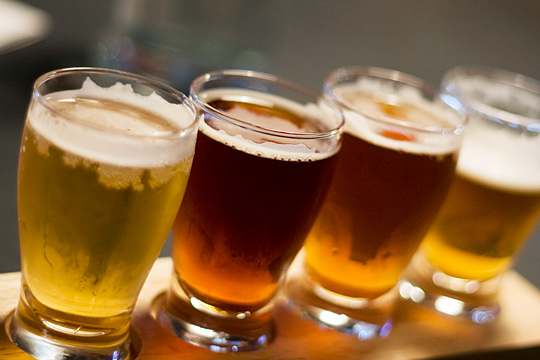Culture
The Man Who Invented Beer: Ales vs. Lagers

Every Wednesday in The Man Who Invented Beer, Adam Cowden runs down the latest developments in the world of craft beer, usually with a history lesson for flavor.
This week, we’re going to momentarily shift gears in order to clear up a common misconception. Specifically, I want to clear up the mass of confusion surrounding the difference between ales and lagers. Contrary to popular belief, ale and lager are not merely interchangable synonyms for “beer,” nor are they words that denote beer styles. Yet all beers can be classified as an ale or lager. So what’s the difference mean? The distinction, as it turns out, is microscopic.
Ale
For the vast majority of (fermented) history, ale and beer were two words for the same thing. Even the thick, porridge-like gruel drank by the Egyptians and the Sumerians was technically ale. Early brewers didn’t know the science behind the fermentation process, but nowadays the naturally occuring airborne strain of yeast responsible for spontaneous fermentation is known as Saccharomyces cervisiae. This strain of yeast ferments best at warmer temperatures (around 75° F) and rises to the top of the vat during fermentation. For this reason, beer snobs will often refer to ales as top-fermented beers. Ales ferment relatively quickly (sometimes in just a few days’ time), although brewers often allow them to mature for longer in secondary fermentation phases. This warm, quick fermentation process produces a stronger, fuller tasting beer rich in chemical byproducts called “esters” that produce subtle “fruity” tastes. Traditionally, ales are also thought to taste best when served at “cellar temperature” (50-55° F), which is why “real ale” served from casks in British pubs is considered warm by drinkers accustomed to mass-produced lagers.
Ales span a wide range of styles, and in general are much more varied/experimental than lagers. This is in part due to the fact that lagers developed in Bavaria, where they were subject to the restrictions of a 1516 Bavarian beer purity law known as the Reinheitsgebot. IPAs, ESBs, stouts, porters, wheat beers and hefeweizens, lambics, and Trappist beers are all classified as ales, as well as most other specialty beers. Amongst beer connoisseurs, ales are generally higher-regarded than lagers. This is in part because of their dominance of cheap mass-produced lagers in the beer market, but also because ales are more complex and flavorful. Newcastle Brown Ale and Guinness are probably the best-selling and most-recognizable ales worldwide.
Lager
Lager is ale’s younger, more popular brother. Much younger, actually. Lagers didn’t arrive on the scene until the late 15th or early 16th century. Lager comes from the German lagern, which means “to store,” and lagers were developed in Bavaria as a result of the practice of lagering (storing) beers in cool caves for later consumption. Bavarian brewers found that beer that fermented in these lagering caves to be cleaner and crisper that top-fermenting ales, and it was later discovered that this was because the lagering process naturally selected a different strand of yeast acted at a lower temperature than the top-fermenting Saccharomyces cervisiae. This new bottom-fermenting yeast was first isolated and described at the Carslberg brewery in 1904 and named Saccharomyces carlsbergensis, but is today known as Saccharomyces pastorianus. In order to fully the describe the development of this yeast we would have to delve into a complex discussion of genetics and taxonomy, so suffice it to say that lager yeast descends from a strain of yeast known as Saccharomyces eubayanus native to the forests of Patagonia in South America. How this yeast made the long voyage across the ocean is somewhat of a mystery, but the development of lager around the same time as the development of trans-Atlantic trade may not be a coincidence.
Unlike ale yeast, Saccharomyces pastorianus works best at lower temperatures (46-59°F) and acts slowly over the course of weeks or even months. Lager yeast also is able to metabolize sulfites, and this is what lends lager a “rotten egg” smell during fermentation. This slow, cold fermentation prohibits the development of the fruity esters associated with ales and produces a beer that is considered very crisp and clean. Unlike ales, lagers are thought to taste best when served cold. While lagers are actually harder to brew than ales, it is generally easier to mass-produce a passable, decent-tasting lager using cheap ingredients than an ale since the crispness and coolness help inhibit unpleasant flavors in a lager. Today, lagers account for more than 90% of beer consumed in the world, and all of the top 10 best-selling beers in the world are lagers. Most of the beer you’re familiar with, and nearly all of the beer you drank in college, was lager. This includes Bud Light (the best-selling beer in the U.S.), Budweiser, Miller, Miller Lite, Natural Lite, and Keystone, as well as “national” brands like Heineken, Sapporo, Carlsberg, Stella Artois, Kronenberg, and Corona. The best-selling beer in the world, China’s Snow Beer, is also a lager.
So that’s the story! If you want to learn more, you can refer to:
Bibliography/Continued Reading
http://www.beertutor.com/articles/ales_vs_lagers.shtml
http://www.beer-faq.com/difference-ale-lager/
http://www.popsci.com/science/article/2013-01/beersci-what-difference-between-lager-and-ale